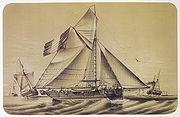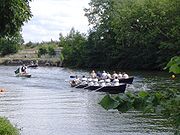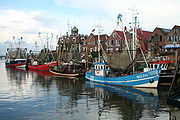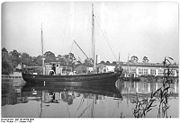
Cutter
Encyclopedia

Fore-and-aft rig
A fore-and-aft rig is a sailing rig consisting mainly of sails that are set along the line of the keel rather than perpendicular to it. Such sails are described as fore-and-aft rigged....
ged, with two or more headsail
Headsail
A headsail of a sailing vessel is any sail set forward of the foremost mast. The most common headsails are staysails, a term that includes jibs and the larger genoa...
s and often a bowsprit
Bowsprit
The bowsprit of a sailing vessel is a pole extending forward from the vessel's prow. It provides an anchor point for the forestay, allowing the fore-mast to be stepped farther forward on the hull.-Origin:...
. The cutter features a mast
Mast (sailing)
The mast of a sailing vessel is a tall, vertical, or near vertical, spar, or arrangement of spars, which supports the sails. Large ships have several masts, with the size and configuration depending on the style of ship...
set farther back than on a sloop
Sloop
A sloop is a sail boat with a fore-and-aft rig and a single mast farther forward than the mast of a cutter....
. A cutter may also refer to a small boat assigned to a larger boat which is used to ferry passengers or light stores between larger boats and the shore. This type of cutter may be powered by oars, sails or a motor. In modern usage among various naval services, a cutter can be a small or medium sized vessel such as those frequently used by harbor services to carry harbor pilots or for law enforcement by the U.S. Coast Guard
United States Coast Guard
The United States Coast Guard is a branch of the United States Armed Forces and one of the seven U.S. uniformed services. The Coast Guard is a maritime, military, multi-mission service unique among the military branches for having a maritime law enforcement mission and a federal regulatory agency...
and the UK Border Agency
UK Border Agency
The UK Border Agency is the border control body of the United Kingdom government and part of the Home Office. It was formed on 1 April 2008 by a merger of the Border and Immigration Agency , UKvisas and the Detection functions of HM Revenue and Customs...
.
Sailing

Jib
A jib is a triangular staysail set ahead of the foremast of a sailing vessel. Its tack is fixed to the bowsprit, to the bow, or to the deck between the bowsprit and the foremost mast...
s on a fixed bowsprit.
Cutters had a rig with a single mast more centrally located, which could vary from 50% to 70% of the length of the sailplan, with multiple headsails and a running bowsprit. A mast located aft of 50% would be considered a mast aft rig
Mast aft rig
A mast aft rig, alternately referred to as aft-mast rig, is a sailboat sail-plan that uses a single mast set in the aft half of the hull. The mast supports fore-sails that may consist of a single jib multiple staysails, or a crab claw sail. The mainsail is either small or completely absent...
.
Somewhere in the 1950s or 1960s there was a shift in these definitions such that a sloop only flew one headsail and a cutter had multiple headsails and mast position became irrelevant. In this modern idiom, a cutter is a sailing
Sailing
Sailing is the propulsion of a vehicle and the control of its movement with large foils called sails. By changing the rigging, rudder, and sometimes the keel or centre board, a sailor manages the force of the wind on the sails in order to move the boat relative to its surrounding medium and...
vessel with more than one head sail and one mast
Mast (sailing)
The mast of a sailing vessel is a tall, vertical, or near vertical, spar, or arrangement of spars, which supports the sails. Large ships have several masts, with the size and configuration depending on the style of ship...
. Cutters carry a staysail
Staysail
A staysail is a fore-and-aft rigged sail whose luff can be affixed to a stay running forward from a mast to the deck, the bowsprit or to another mast....
directly in front of the mast, set from the forestay
Forestay
On a sailing vessel, a forestay, sometimes just called a stay, is a piece of standing rigging which keeps a mast from falling backwards. It is attached either at the very top of the mast, or in fractional rigs between about 1/8 and 1/4 from the top of the mast. The other end of the forestay is...
. A traditional vessel would also normally have a bowsprit
Bowsprit
The bowsprit of a sailing vessel is a pole extending forward from the vessel's prow. It provides an anchor point for the forestay, allowing the fore-mast to be stepped farther forward on the hull.-Origin:...
to carry one or more jib
Jib
A jib is a triangular staysail set ahead of the foremast of a sailing vessel. Its tack is fixed to the bowsprit, to the bow, or to the deck between the bowsprit and the foremost mast...
s from its end via jibstay(s) on travelers (to preserve the ability to reef the bowsprit). In modern vessels the jib may be set from a permanent stay fixed to the end of a fixed (non-reeving) bowsprit, or directly to the stem fitting of the bow itself. In these cases, that may be referred to as the forestay, and the inner one, which will be less permanent in terms of keeping the mast up, may be called the stays'l stay. A sloop
Sloop
A sloop is a sail boat with a fore-and-aft rig and a single mast farther forward than the mast of a cutter....
carries only one head sail, called either the foresail
Foresail
A foresail is one of a few different types of sail set on the foremost mast of a sailing vessel:* A fore and aft sail set on the foremast of a schooner or similar vessel....
or jib..
The cutter rig, especially a gaff rig
Gaff rig
Gaff rig is a sailing rig in which the sail is four-cornered, fore-and-aft rigged, controlled at its peak and, usually, its entire head by a spar called the gaff...
version where the sails aft of the mast was divided between a mainsail below the gaff and a topsail above, was useful for sailing with small crews as the total sail area was divided into smaller individual sails. These could be managed without the need for large crews, winch
Winch
A winch is a mechanical device that is used to pull in or let out or otherwise adjust the "tension" of a rope or wire rope . In its simplest form it consists of a spool and attached hand crank. In larger forms, winches stand at the heart of machines as diverse as tow trucks, steam shovels and...
es, or complex tackles
Block and tackle
A block and tackle is a system of two or more pulleys with a rope or cable threaded between them, usually used to lift or pull heavy loads.The pulleys are assembled together to form blocks so that one is fixed and one moves with the load...
, making the cutter especially suitable for pilot, customs and coast guard
Coast guard
A coast guard or coastguard is a national organization responsible for various services at sea. However the term implies widely different responsibilities in different countries, from being a heavily armed military force with customs and security duties to being a volunteer organization tasked with...
duties. For example, a pilot cutter may only have two people on board for its outward trip—the pilot to be delivered to a ship and an assistant who had to sail the cutter back to port single-handed. The cutter sailing rig became so ubiquitous for these tasks that the modern-day motorised vessels now engaged in these duties are known as 'cutters'.
Rowing

Transom (nautical)
In naval architecture, a transom is the surface that forms the stern of a vessel. Transoms may be flat or curved and they may be vertical, raked forward, also known as a retroussé or reverse transom, angling forward from the waterline to the deck, or raked aft, often simply called "raked", angling...
, was broader in proportion compared to the longboat
Longboat
In the days of sailing ships, a vessel would carry several ship's boats for various uses. One would be a longboat, an open boat to be rowed by eight or ten oarsmen, two per thwart...
, which had finer lines.
The Watermen
Watermen
Watermen are river workers who transfer passengers across and along city centre rivers and estuaries in Britain and its colonies. Most notable are those on the River Thames and River Medway, but other rivers such as the River Tyne and River Dee, Wales also had their watermen who formed guilds in...
of London
London
London is the capital city of :England and the :United Kingdom, the largest metropolitan area in the United Kingdom, and the largest urban zone in the European Union by most measures. Located on the River Thames, London has been a major settlement for two millennia, its history going back to its...
used similar boats in the 18th Century often decorated as depicted in historical prints and pictures of the River Thames
River Thames
The River Thames flows through southern England. It is the longest river entirely in England and the second longest in the United Kingdom. While it is best known because its lower reaches flow through central London, the river flows alongside several other towns and cities, including Oxford,...
in the 17th & 18th Centuries. The modern Waterman’s Cutter is based on drawings of these boats. They are 34 feet (10.4 m) long with a beam of 4 in 6 in (1.37 m) They can have up to six oarsmen either rowing or sculling and can carry a cox and passengers. The organisers of the Great River Race
Great River Race
The Great River Race is an annual competition held on the River Thames for any traditional-style coxed boat propelled by oars or paddles.The competition was started in 1988 and covers a 21 mile course on the tidal Thames between Ham, London and Greenwich...
developed the modern version in the 1980s and now many of the fleet of 24 compete annually in this "Marathon of the River". Watermen’s Cutters also compete annually in the Port of London
Port of London
The Port of London lies along the banks of the River Thames from London, England to the North Sea. Once the largest port in the world, it is currently the United Kingdom's second largest port, after Grimsby & Immingham...
Challenge, and the Port Admirals’ Challenge. Cutter races are also to be found at various town rowing and skiffing
Skiffing
Skiffing refers to the sporting and leisure activity of rowing a Thames skiff. A Thames skiff is a traditional hand built clinker-built wooden craft of a design which has been seen on the River Thames and other waterways in England and other countries for nearly 200 years...
regattas. In addition the cutters perform the role of ceremonial Livery
Livery Company
The Livery Companies are 108 trade associations in the City of London, almost all of which are known as the "Worshipful Company of" the relevant trade, craft or profession. The medieval Companies originally developed as guilds and were responsible for the regulation of their trades, controlling,...
Barges with the canopies and armorial flags flying on special occasions.
Cutters have been used for record-breaking attempts and crews have achieved record times for sculling
Sculling
Sculling generally refers to a method of using oars to propel watercraft in which the oar or oars touch the water on both the port and starboard sides of the craft, or over the stern...
the English Channel
English Channel
The English Channel , often referred to simply as the Channel, is an arm of the Atlantic Ocean that separates southern England from northern France, and joins the North Sea to the Atlantic. It is about long and varies in width from at its widest to in the Strait of Dover...
(2hrs 42mins) in 1996 and for sculling non-stop from London to Paris (4days 15minutes) in 1999.
Pulling
A pulling cutter was a boat carried by sailing ships for work in fairly sheltered water in which load-carrying capacity was needed, for example in laying a kedge. This operation was the placing of a relatively light anchor at a distance from the ship so as to be able to haul her off in its direction. The oars were double-banked. That is, there were two oarsmen on each thwart. In a seaway, the longboat was preferred to the cutter as the finer lines of the stern of the former meant that it was less likely to broach to in a following sea. In the Royal NavyRoyal Navy
The Royal Navy is the naval warfare service branch of the British Armed Forces. Founded in the 16th century, it is the oldest service branch and is known as the Senior Service...
the cutters were replaced by 25 and 32 feet (9.8 m) motor cutters. However, the cutters' traditional work had grown beyond the capacity of a boat as ships became larger. Though primarily a pulling boat, this cutter could also be rigged for sailing.
Pilot Cutter

Maritime pilot
A pilot is a mariner who guides ships through dangerous or congested waters, such as harbours or river mouths. With the exception of the Panama Canal, the pilot is only an advisor, as the captain remains in legal, overriding command of the vessel....
s from harbour to incoming large trading vessels.
As most early pilots were local fisherman
Fisherman
A fisherman or fisher is someone who captures fish and other animals from a body of water, or gathers shellfish. Worldwide, there are about 38 million commercial and subsistence fishermen and fish farmers. The term can also be applied to recreational fishermen and may be used to describe both men...
who undertook both jobs, although licensed by the harbour to operate within their jurisdiction, pilots were generally self-employed, and the quickest transport meant greater income. As their fishing boats were heavy working boats, and filled with fishing equipment, they needed a new type of boat.
Early boats were developed from single masted fishing cutter designs and twin masted yawl
Yawl
A yawl is a two-masted sailing craft similar to a sloop or cutter but with an additional mast located well aft of the main mast, often right on the transom, specifically aft of the rudder post. A yawl (from Dutch Jol) is a two-masted sailing craft similar to a sloop or cutter but with an...
s, and latterly into the specialist pilot cutter. These were effectively light-weight and over powered single masted boats with large steeply angled keels, making them deep draft
Draft (hull)
The draft of a ship's hull is the vertical distance between the waterline and the bottom of the hull , with the thickness of the hull included; in the case of not being included the draft outline would be obtained...
under power and shallow draft in lighter sail.
If legend is to be believed the first official Bristol Channel
Bristol Channel
The Bristol Channel is a major inlet in the island of Great Britain, separating South Wales from Devon and Somerset in South West England. It extends from the lower estuary of the River Severn to the North Atlantic Ocean...
pilot was barge master George James Ray, appointed by the Corporation of Bristol in May 1497 to pilot John Cabot
John Cabot
John Cabot was an Italian navigator and explorer whose 1497 discovery of parts of North America is commonly held to have been the first European encounter with the continent of North America since the Norse Vikings in the eleventh century...
's from Bristol harbour
Bristol Harbour
Bristol Harbour is the harbour in the city of Bristol, England. The harbour covers an area of . It has existed since the 13th century but was developed into its current form in the early 19th century by installing lock gates on a tidal stretch of the River Avon in the centre of the city and...
to the open sea beyond the Bristol channel
Bristol Channel
The Bristol Channel is a major inlet in the island of Great Britain, separating South Wales from Devon and Somerset in South West England. It extends from the lower estuary of the River Severn to the North Atlantic Ocean...
. In 1837 Pilot George Ray guided Brunel's , and in 1844 William Ray piloted the larger on her maiden voyage.
Customs services
.jpg)


United States Coast Guard
The United States Coast Guard is a branch of the United States Armed Forces and one of the seven U.S. uniformed services. The Coast Guard is a maritime, military, multi-mission service unique among the military branches for having a maritime law enforcement mission and a federal regulatory agency...
(Revenue Cutter Service) or the customs services of other countries.
In America, customs cutters were commonly schooner
Schooner
A schooner is a type of sailing vessel characterized by the use of fore-and-aft sails on two or more masts with the forward mast being no taller than the rear masts....
s or brig
Brig
A brig is a sailing vessel with two square-rigged masts. During the Age of Sail, brigs were seen as fast and manoeuvrable and were used as both naval warships and merchant vessels. They were especially popular in the 18th and early 19th centuries...
s. In Britain, they were usually rigged as defined under Sailing (above). The British Board of Customs also used other vessels as hulks
Hulk (ship)
A hulk is a ship that is afloat, but incapable of going to sea. Although sometimes used to describe a ship that has been launched but not completed, the term most often refers to an old ship that has had its rigging or internal equipment removed, retaining only its flotational qualities...
, which were moored in places such as tidal creeks
Creek (tidal)
A tidal creek, tidal channel, or estuary is the portion of a stream that is affected by ebb and flow of ocean tides, in the case that the subject stream discharges to an ocean, sea or strait. Thus this portion of the stream has variable salinity and electrical conductivity over the tidal cycle...
. Customs officers worked from the hulks in smaller boats.
In the UK, the UK Border Agency
UK Border Agency
The UK Border Agency is the border control body of the United Kingdom government and part of the Home Office. It was formed on 1 April 2008 by a merger of the Border and Immigration Agency , UKvisas and the Detection functions of HM Revenue and Customs...
(successor to HM Customs and Excise) currently operates a fleet of 42 m Corvette-type vessels throughout UK territorial waters as border cutters, inspecting vessels for illicit cargoes.
See also
- YachtYachtA yacht is a recreational boat or ship. The term originated from the Dutch Jacht meaning "hunt". It was originally defined as a light fast sailing vessel used by the Dutch navy to pursue pirates and other transgressors around and into the shallow waters of the Low Countries...
- United States Coast Guard CutterUnited States Coast Guard CutterCutter is the term used by the United States Coast Guard for its commissioned vessels. A Cutter is or greater in length, has a permanently assigned crew, and has accommodations for the crew to live aboard...
- Classic Boat (magazine)Classic Boat (magazine)Classic Boat is a British traditional boating magazine published by The Chelsea Magazine Company. It was first published in 1987 and defines classic boats as "boats which endure". It was the first magazine in the UK dedicated to traditional boats and boating.The magazine covers boats of all sizes...
- ClipperClipperA clipper was a very fast sailing ship of the 19th century that had three or more masts and a square rig. They were generally narrow for their length, could carry limited bulk freight, small by later 19th century standards, and had a large total sail area...

